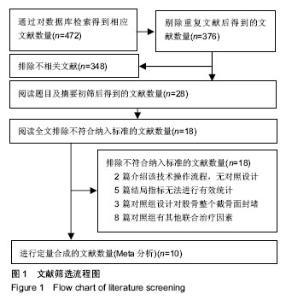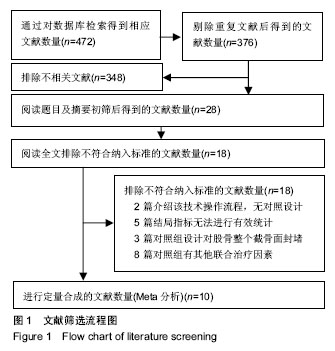Chinese Journal of Tissue Engineering Research ›› 2019, Vol. 23 ›› Issue (4): 636-642.doi: 10.3969/j.issn.2095-4344.0614
Previous Articles Next Articles
Sealing of intramedullar femoral canal for blood loss after total knee arthroplasty: a meta-analysis
Lu Chao1, Liu Wengang1, Wu Huai1, Ye Guozhu1, 2, Chen Guocai1, 2, Chen Jin1, 2
- 1Guangdong Second Traditional Chinese Medicine Hospital, Guangzhou 510095, Guangdong Province, China; 2Guangzhou University of Chinese Medicine, Guangzhou 510405, Guangdong Province, China
-
Online:2019-02-08Published:2019-02-08 -
Contact:Liu Wengang, MD, Chief physician, Master’s supervisor, Guangdong Second Traditional Chinese Medicine Hospital, Guangzhou 510095, Guangdong Province, China -
About author:Lu Chao, Master, Attending physician, Guangdong Second Traditional Chinese Medicine Hospital, Guangzhou 510095, Guangdong Province, China -
Supported by:the Major Special Construction Project of State Administration of Traditional Chinese Medicine of China, No. (2012)7; the Domination Disease Breakthrough Project of Chinese Medicine in Guangdong Province, No. (2015)19
CLC Number:
Cite this article
Lu Chao, Liu Wengang, Wu Huai, Ye Guozhu, Chen Guocai, Chen Jin. Sealing of intramedullar femoral canal for blood loss after total knee arthroplasty: a meta-analysis[J]. Chinese Journal of Tissue Engineering Research, 2019, 23(4): 636-642.
share this article
Add to citation manager EndNote|Reference Manager|ProCite|BibTeX|RefWorks
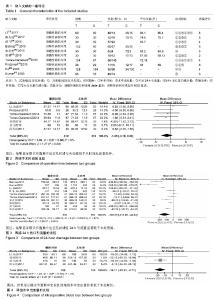
2.2 Meta分析结果 2.2.1 手术时间比较 8个临床对照试验报告了手术时 间[12-14,17-19],共623例患者,试验组310例,对照组313例。经过异质性检验手术时间(χ2=3.99,P=0.68,I2=0%),各研究组间无异质性,采用固定效应模型。结果显示两组手术时间差异无显著意义(MD=-1.25,95%CI=[-3.19,0.68],P=0.20),见图2。提示定位孔封堵并不增加手术时间。 2.2.2 24 h伤口引流量 10个临床对照试验报告了24 h伤口引流量[12-18,20-21],共1 202例患者,试验组639例,对照组563例。经过异质性检验(χ2=268.79,P < 0.001,I2= 97%),各研究组间有异质性,采用随机效应模型。结果显示两组24 h伤口引流量差异有显著性意义(MD= -128.05,95%CI=[-212.06,-44.04],P < 0.001),见图3。提示定位孔封堵能减少24 h引流量。 2.2.3 术中出血量 4个临床对照试验报告了术中出血 量[12-14,17],共300例患者,试验组150例,对照组150例。经过异质性检验(χ2=1.03,P=0.79,I2=0%),各研究组间无异质性,采用固定效应模型。结果显示两组术中出血量差异有显著性意义(MD=-16.11,95%CI=[-23.51,-8.71],P < 0.000 1),见图4。提示定位孔封堵能明显减少术中出血量。"
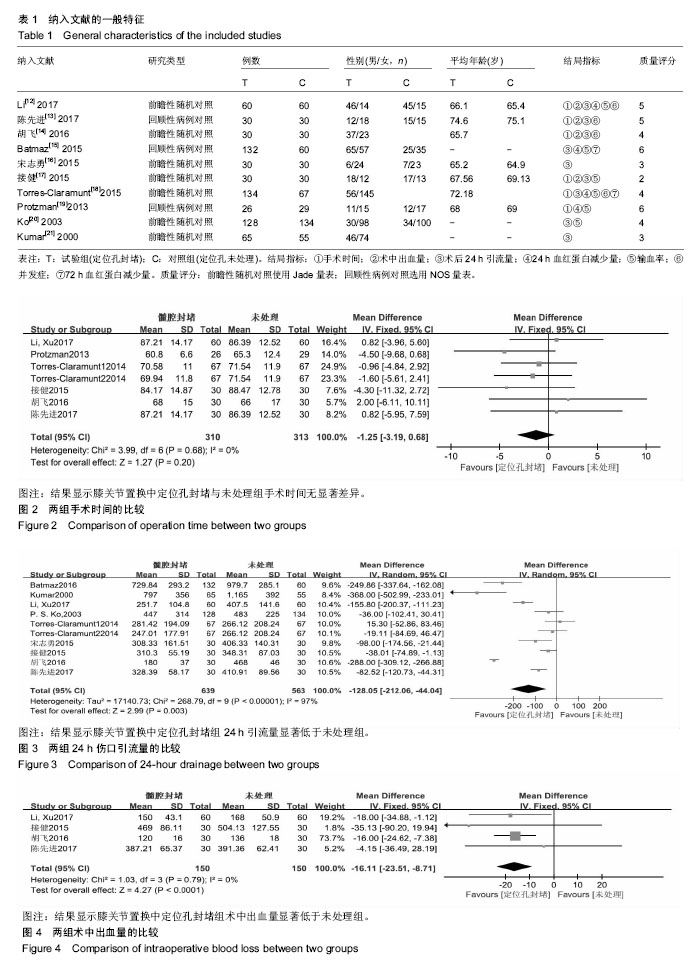
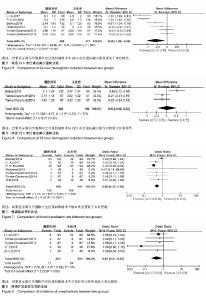
2.2.4 24 h血红蛋白减少量 共有6个临床对照试验报告了24 h血红蛋白减少量[12,15,18-20],共计897例患者,试验组480例,对照组417例。经过异质性检验(χ2=46.68, P < 0.001,I2=89%),各研究组间有异质性,采用随机效应模型。结果显示两组24 h血红蛋白减少量有显著差异(MD=-0.58,95%CI=[-1.08,0.08],P=0.02),见图5。提示试验组24 h血红蛋白减少量显著低于对照组。 2.2.5 72 h血红蛋白减少量 共有3个临床对照试验报告了72 h血红蛋白减少量[15,18],共460例患者,试验组266例,对照组194例。经过异质性检验(χ2=8.72,P=0.01,I2=77%),各研究组间有异质性,采用随机效应模型。结果显示两组72 h血红蛋白减少量无显著差异(MD=0.03,95% CI=[-0.46,0.52],P=0.9),见图6。提示试验组72 h血红蛋白减少量与对照组无显著差异。 2.2.6 输血率 共有7个临床对照试验报告了输血 率[12,15,17,18-20],共957例患者,试验组510例,对照组447例。经过异质性检验输血率(χ2=7.9,P=0.25,I2=24%),各研究组间无异质性,采用固定效应模型。结果显示2组输血率差异有显著性意义(OR=0.50,95%CI=[0.36,0.68],P < 0.001),见图7。提示定位孔封堵能降低输血率。 2.2.7 并发症发生率 5个临床对照试验篇文献报告了并发症[12-14,18],共508例患者,试验组254例,对照组254例。经过异质性检验(χ2=2.29,P=0.68,I2=0%),各研究组间无异质性,采用固定效应模型。结果显示两组 并发症差异有统计学意义(OR=0.44,95%CI=[0.21,0.91],P=0.03),见图8。提示定位孔封堵能降低术后并发症。"
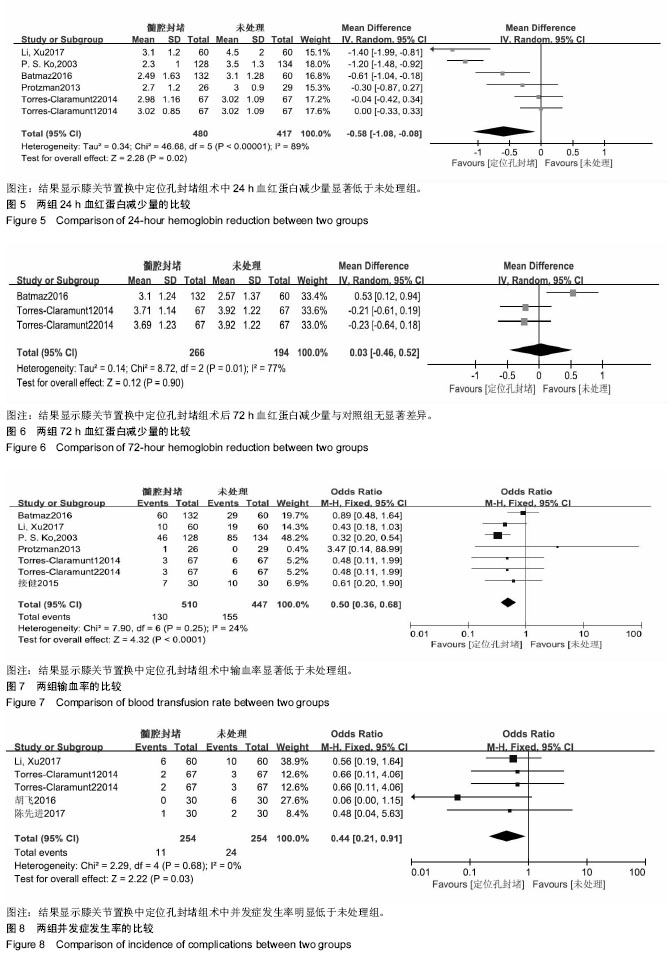
| [1] Yamaguchi S, Ohno G, Kitamura J. Evaluation of perioperative blood loss and transfusion in total knee arthroplasty. Masui. 2014; 63:1029-1033. [2] Ma J, Huang Z, Shen B, et al. Blood management of staged bilateral total knee arthroplasty in a single hospitalization period. J Orthop Surg Res. 2014;9(1):116. [3] Spahn DR. Anemia and patient blood management in hip and knee surgery: a systematic review of the literature. Anesthesiology. 2010;113(2):482-495. [4] 董翠翠,贺付成.局部应用和静脉注射氨甲环酸对全膝关节置换术术后出血影响的Meta分析[J].中国矫形外科杂志, 2015,23(22): 2070-2074.[5] 万伏银,郭万首,程立明,等.局部应用骨蜡和氨甲环酸在全膝关节置换术中止血作用的比较[J].中国矫形外科杂志, 2016,24(3):193-197.[6] Eubanks JD. Antifibrinolytics in major orthopaedic surgery. J Am Acad Orthop Surg. 2010;18(3):132-138. [7] Maniar RN, Kumar G, Singhi T, et al. Most effective regimen of tranexamic acid in knee arthroplasty: a prospective randomized controlled study in 240 patients. Clin Orthop Relat Res. 2012; 470(9):2605-2612. [8] Zhang H, Chen J, Chen F, et al. The effect of tranexamic acid on blood loss and use of blood products in total knee arthroplasty: a meta-analysis. Knee Surg Sports Traumatol Arthrosc. 2012; 20(9): 1742-1752. [9] Roy SP, Tanki UF, Dutta A, et al. Efficacy of intra-articular tranexamic acid in blood loss reduction following primary unilateral total knee arthroplasty. Knee Surg Sports Traumatol Arthrosc. 2012;20(12):2494-2501. [10] Thienpont E. Faster recovery after minimally invasive surgery in total knee arthroplasty. Knee Surg Sports Traumatol Arthrosc. 2013;21(10):2412-2417. [11] Higgins JPT, Green S. Cochrane handbook for systematic reviews of interventions version 5. 1. 0. the cochrane collaboration. 2011; 17(4):535. [12] Li X, Qi XB, Han X, et al. Effects of sealing the intramedullary femoral canal in total knee arthroplasty: A randomized study. Medicine (Baltimore). 2017;96(29):e7388. [13] 陈先进,张道平,程后庆,等.股骨髓内定位孔填塞技术在全膝关节置换术中的应用[J].中国骨与关节损伤杂志,2017,32(8):893.[14] 胡飞,尚希福,朱亚林,等.股骨髓内定位通道嵌压植骨减少全膝置换术后出血的前瞻性研究[J].中国矫形外科杂志, 2016,24(17): 1566-1569.[15] Batmaz AG, Kayaalp ME, Oto O, et al. Sealing of femoral tunnel with autologous bone graft decreases blood loss. Acta Chir Orthop Traumatol Cech. 2016;83(5):348-350. [16] 宋志勇,王明礼,郭得辛,等.中老年患者膝关节表面置换术中股骨髓内定位孔封堵对术后失血量的影响[J].中国老年学杂志, 2015,35(17): 4997-4998.[17] 接健,陈福扬,徐国浩,等.髓内定位孔骨塞对全膝关节置换术中出血综合控制作用的对照研究[J].中国骨与关节损伤杂志, 2015,30(10): 1049-1051.[18] Torres-Claramunt R, Hinarejos P, Pérez-Prieto D, et al. Sealing of the intramedullar femoral canal in a TKA does not reduce postoperative blood loss: a randomized prospective study. Knee. 2014;21(4):853-857. [19] Protzman NM,Buck NJ,Weiss CB. Autologous bone plugs in unilateral total knee arthroplasty. Indian J Orthop. 2013;47(2):182-187. [20] Ko PS, Tio MK, Tang YK, et al. Sealing the intramedullary femoral canal with autologous bone plug in total knee arthroplasty. J Arthroplasty. 2003;18(1):6-9. [21] Kumar N, Saleh J, Gardiner E, et al. Plugging the intramedullary canal of the femur in total knee arthroplasty: reduction in postoperative blood loss. J Arthroplasty. 2000;15(7):947-949. [22] Sehat KR, Evans RL, Newman JH. Hidden blood loss following hip and knee arthroplasty Correct management of blood loss should take hidden loss into account. J Bone Joint Surg Br. 2004; 86(4):561-565. [23] Teter KE, Bregman D, Colwell CW Jr. The efficacy of intramedullary femoral alignment in total knee replacement. Clin Orthop Relat Res. 1995;321:117-121. [24] 边焱焱,翁习生,林进,等.人工膝关节表面置换术中胫骨髓内与髓外定位的临床效果比较[J].中国医学科学院学报, 2015,37(4):373-377.[25] Klein MP, Rahn BA, Frigg R, et al. Reaming versus non-reaming in medullary nailing: interference with cortical circulation of the canine tibia. Arch Orthop Trauma Surg. 1990;109(6):314-316. [26] Moo IH, Chen JYQ, Pagkaliwaga EH, et al. Bone wax is effective in reducing blood loss after total knee arthroplasty. J Arthroplasty. 2017;32(5):1483-1487[27] Vulcano E, Regazzola GM, Murena L, et al. Femoral bone plug in total knee replacement. Orthopedics. 2015;38(10):617-618. [28] K?ska R, Paradowski TP, Witoński D. Outcome in primary cemented total knee arthroplasty with or without drain: A prospective comparative study. Indian J Orthop. 2014;48(4): 404-409. [29] Cao L, Ablimit N, Mamtimin A, et al. Comparison of no drain or with a drain after unilateral total knee arthroplasty: a prospective randomized controlled trial. Zhonghua Wai Ke Za Zhi. 2009;18(47): 1390-1393. [30] Gross JB. Estimating allowable blood loss: corrected for dilution. Anesthesiology. 1983;58(3):277-280. [31] Thienpont E. Faster recovery after minimally invasive surgery in total knee arthroplasty. Knee Surg Sports Traumatol Arthrosc. 2013;21(10):2412-2417. [32] Roy SP, Tanki UF, Dutta A, et al. Efficacy of intra-articular tranexamic acid in blood loss reduction following primary unilateral total knee arthroplasty. Knee Surg Sports Traumatol Arthrosc. 2012;20(12):2494-2501. [33] Maniar RN, Kumar G, Singhi T, et al. Most effective regimen of tranexamic acid in knee arthroplasty: a prospective randomized controlled study in 240 patients. Clin Orthop Relat Res. 2012; 470(9):2605-2612. [34] Sarkanovi? ML, Gvozdenovi? L, Savi? D, et al. Autologous blood transfusion in total knee replacement surgery. Vojnosanit Pregl. 2013;70(3):274-278. [35] Thomassen BJ, den Hollander PH, Kaptijn HH, et al. Autologous wound drains have no effect on allogeneic blood transfusions in primary total hip and knee replacement: a three-arm randomised trial. Bone Joint J. 2014;96-B(6):765-771. [36] 余存泰,覃健,侯之启,等.全膝关节置换术隐性失血的初步研究[J].中国骨与关节损伤杂志,2006,21(10):784-786. |
| [1] | Zhang Yu, Tian Shaoqi, Zeng Guobo, Hu Chuan. Risk factors for myocardial infarction following primary total joint arthroplasty [J]. Chinese Journal of Tissue Engineering Research, 2021, 25(9): 1340-1345. |
| [2] | Li Dadi, Zhu Liang, Zheng Li, Zhao Fengchao. Correlation of total knee arthroplasty efficacy with satisfaction and personality characteristics [J]. Chinese Journal of Tissue Engineering Research, 2021, 25(9): 1346-1350. |
| [3] | Wei Wei, Li Jian, Huang Linhai, Lan Mindong, Lu Xianwei, Huang Shaodong. Factors affecting fall fear in the first movement of elderly patients after total knee or hip arthroplasty [J]. Chinese Journal of Tissue Engineering Research, 2021, 25(9): 1351-1355. |
| [4] | Wang Jinjun, Deng Zengfa, Liu Kang, He Zhiyong, Yu Xinping, Liang Jianji, Li Chen, Guo Zhouyang. Hemostatic effect and safety of intravenous drip of tranexamic acid combined with topical application of cocktail containing tranexamic acid in total knee arthroplasty [J]. Chinese Journal of Tissue Engineering Research, 2021, 25(9): 1356-1361. |
| [5] | Xiao Guoqing, Liu Xuanze, Yan Yuhao, Zhong Xihong. Influencing factors of knee flexion limitation after total knee arthroplasty with posterior stabilized prostheses [J]. Chinese Journal of Tissue Engineering Research, 2021, 25(9): 1362-1367. |
| [6] | Huang Zexiao, Yang Mei, Lin Shiwei, He Heyu. Correlation between the level of serum n-3 polyunsaturated fatty acids and quadriceps weakness in the early stage after total knee arthroplasty [J]. Chinese Journal of Tissue Engineering Research, 2021, 25(9): 1375-1380. |
| [7] | Zhang Chong, Liu Zhiang, Yao Shuaihui, Gao Junsheng, Jiang Yan, Zhang Lu. Safety and effectiveness of topical application of tranexamic acid to reduce drainage of elderly femoral neck fractures after total hip arthroplasty [J]. Chinese Journal of Tissue Engineering Research, 2021, 25(9): 1381-1386. |
| [8] | Yuan Jiawei, Zhang Haitao, Jie Ke, Cao Houran, Zeng Yirong. Underlying targets and mechanism of Taohong Siwu Decoction in prosthetic joint infection on network pharmacology [J]. Chinese Journal of Tissue Engineering Research, 2021, 25(9): 1428-1433. |
| [9] | Chen Junming, Yue Chen, He Peilin, Zhang Juntao, Sun Moyuan, Liu Youwen. Hip arthroplasty versus proximal femoral nail antirotation for intertrochanteric fractures in older adults: a meta-analysis [J]. Chinese Journal of Tissue Engineering Research, 2021, 25(9): 1452-1457. |
| [10] | Chen Jinping, Li Kui, Chen Qian, Guo Haoran, Zhang Yingbo, Wei Peng. Meta-analysis of the efficacy and safety of tranexamic acid in open spinal surgery [J]. Chinese Journal of Tissue Engineering Research, 2021, 25(9): 1458-1464. |
| [11] | Hu Kai, Qiao Xiaohong, Zhang Yonghong, Wang Dong, Qin Sihe. Treatment of displaced intra-articular calcaneal fractures with cannulated screws and plates: a meta-analysis of 15 randomized controlled trials [J]. Chinese Journal of Tissue Engineering Research, 2021, 25(9): 1465-1470. |
| [12] | Huang Dengcheng, Wang Zhike, Cao Xuewei. Comparison of the short-term efficacy of extracorporeal shock wave therapy for middle-aged and elderly knee osteoarthritis: a meta-analysis [J]. Chinese Journal of Tissue Engineering Research, 2021, 25(9): 1471-1476. |
| [13] | Wang Yongsheng, Wu Yang, Li Yanchun. Effect of acute high-intensity exercise on appetite hormones in adults: a meta-analysis [J]. Chinese Journal of Tissue Engineering Research, 2021, 25(8): 1305-1312. |
| [14] | Kong Desheng, He Jingjing, Feng Baofeng, Guo Ruiyun, Asiamah Ernest Amponsah, Lü Fei, Zhang Shuhan, Zhang Xiaolin, Ma Jun, Cui Huixian. Efficacy of mesenchymal stem cells in the spinal cord injury of large animal models: a meta-analysis [J]. Chinese Journal of Tissue Engineering Research, 2021, 25(7): 1142-1148. |
| [15] | Zhong Hehe, Sun Pengpeng, Sang Peng, Wu Shuhong, Liu Yi. Evaluation of knee stability after simulated reconstruction of the core ligament of the posterolateral complex [J]. Chinese Journal of Tissue Engineering Research, 2021, 25(6): 821-825. |
| Viewed | ||||||
|
Full text |
|
|||||
|
Abstract |
|
|||||
